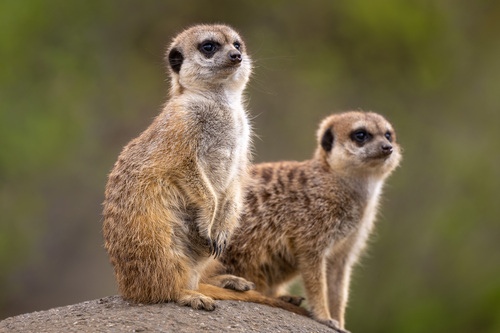
Meerkat
The meerkat, Suricata suricatta, thrives in the harsh deserts of Southern Africa. These sociable creatures stand sentinel, watching for danger while their clan forages. With distinctive eye markings and a playful demeanor, meerkats embody teamwork and survival, playing a vital role in controlling insect populations.
10-14 years
Lifespan
600.0 - 975.0 g
Weight
Height: 25 - 35 cm
Size
Brown, Yellow, Black, White, Tan
Color
1 year
Age of Sexual Maturity
4-6 weeks
Age of Weaning
20 mph
Top Speed
Least Concern
Conservation Status
Stable
Population Trend
Characteristics
Meerkats, or Suricata suricatta, are social mammals native to the arid regions of Southern Africa. Known for their upright stance, they live in large groups called mobs or clans. Distinctive features include dark markings around the eyes, which reduce glare from the sun, and a long, slender tail for balance. Meerkats exhibit cooperative behavior, including communal care of young and sentry duty to watch for predators.
Distribution Range of the Meerkat
Suricata suricatta, commonly known as the meerkat, is native to the southern region of the African continent. They are predominantly found in the countries of Botswana, Namibia, Angola, and South Africa. Meerkats inhabit specific regions such as the Kalahari Desert, the Namib Desert, and other parts of the arid and semi-arid scrublands in these countries.
Meerkat's Habitat
Environmental Conditions
Meerkats are adapted to live in arid and semi-arid environments. Their typical habitat includes open plains and savannas, characterized by sparse vegetation, dry grasslands, and sandy soils. The climate in these regions is typically hot and dry, with significant temperature fluctuations between day and night.
Ecological Niche
Meerkats occupy a unique ecological niche as social, burrowing mammals. They live in large groups known as mobs or clans, which can consist of up to 50 individuals. Meerkats are insectivores, primarily feeding on insects, but they also eat small vertebrates, eggs, and plant matter. Their burrowing behavior helps them avoid predators and escape extreme temperatures, while their social structure aids in cooperative care of young and vigilance against threats.
Copyright @ Nature Style Limited. All Rights Reserved.
 English
English